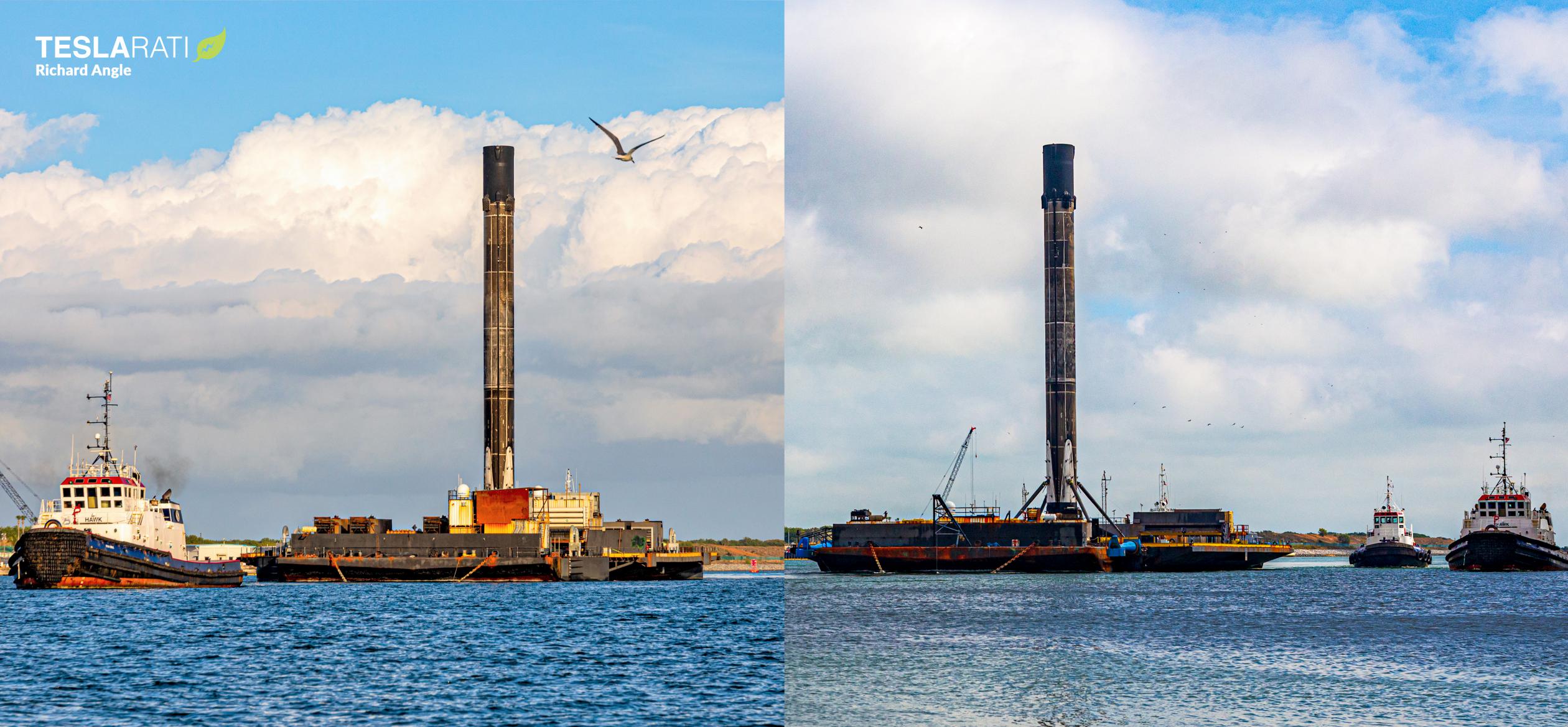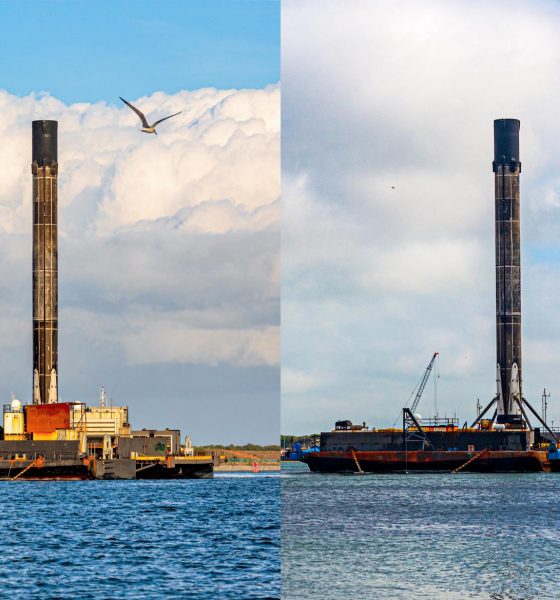

News
SpaceX sleuths spot third drone ship under construction in Louisiana
For the first time, SpaceX fleet-tracking sleuths have confirmed the identity and location – and captured photos – of the company’s third rocket recovery ‘drone ship.’
After several years of waiting for more details and multiple apparent delays, new information and photos allow us to finally determine what exactly that third drone ship – to be named A Shortfall Of Gravitas (ASOG) – will bring to the table when it enters SpaceX’s greater fleet.
While SpaceX could have feasibly gone in any number of directions, ranging from a clean-sheet build to something more akin to Blue Origin’s plans to convert a keeled cargo ship, it appears that the company ultimately settled on the simplest possible option – effectively replicating one of its two existing drone ships. Drone ships Of Course I Still Love You (OCISLY) and Just Read The Instructions (JRTI) are both converted barges based on virtually identical Marmac 303 and 304 vessels.
SpaceX’s barge conversion approach produces recovery ships with a massive, flat 300′ by 200′ (90 by 60 meter) surface perfect for supporting Falcon booster landings. SpaceX has also used the space available to add small garages to each ship for “Octagrabber” robots that allow recovery teams to remotely secure landed boosters – far safer than the hands-on alternative. Barges are also extremely affordable and simple to own, operate, and modify relative to crewed ships, making the conversion and certification process far easier.
Nevertheless, barges are flat-bottomed ships, meaning that they are more or less fully at the mercy of seas and weather, which can often force SpaceX to delay launches. At least as far as SpaceX’s current efforts go, its drone ships are must also be towed by tugboat to and from recovery zones and are only able to use their onboard propulsion for station-keeping once there. That means that SpaceX’s “drone ships” aren’t actually autonomous, per se, and are completely reliant upon several crewed support ships to do their jobs, translating to not-insignificant expenses for each at-sea booster recovery.
Given those challenges and the fact that A Shortfall Of Gravitas was originally expected to enter service some two years ago, it would have been far from surprising if SpaceX took that time to design and build a wholly new kind of rocket recovery ship meant to tackle those established issues. Instead, though, SpaceX appears to be adding an almost identical third ship to its fleet of converted barges, suggesting that the current fleet’s limitations weren’t worth the hassle to solve.
Simultaneously, signs suggest that SpaceX is on the cusp of reactivating its West Coast launch facilities for a dozen or more polar Starlink missions – missions that will very likely require drone ship booster landings for maximum efficiency. As such, it’s entirely possible that one of SpaceX’s three drone ships will immediately head for the Panama Canal as soon as ASOG is ready to enter the fleet. In other words, SpaceX’s East Coast fleet will likely continue to have two drone ships for the indefinite future.
In the meantime, it’s possible that drone ship ASOG could be ready to join its siblings just a few months from now. Stay tuned for updates!

News
Tesla FSD fleet is nearing 7 billion total miles, including 2.5 billion city miles
As can be seen on Tesla’s official FSD webpage, vehicles equipped with the system have now navigated over 6.99 billion miles.

Tesla’s Full Self-Driving (Supervised) fleet is closing in on almost 7 billion total miles driven, as per data posted by the company on its official FSD webpage.
These figures hint at the massive scale of data fueling Tesla’s rapid FSD improvements, which have been quite notable as of late.
FSD mileage milestones
As can be seen on Tesla’s official FSD webpage, vehicles equipped with the system have now navigated over 6.99 billion miles. Tesla owner and avid FSD tester Whole Mars Catalog also shared a screenshot indicating that from the nearly 7 billion miles traveled by the FSD fleet, more than 2.5 billion miles were driven inside cities.
City miles are particularly valuable for complex urban scenarios like unprotected turns, pedestrian interactions, and traffic lights. This is also the difference-maker for FSD, as only complex solutions, such as Waymo’s self-driving taxis, operate similarly on inner-city streets. And even then, incidents such as the San Francisco blackouts have proven challenging for sensor-rich vehicles like Waymos.
Tesla’s data edge
Tesla has a number of advantages in the autonomous vehicle sector, one of which is the size of its fleet and the number of vehicles training FSD on real-world roads. Tesla’s nearly 7 billion FSD miles then allow the company to roll out updates that make its vehicles behave like they are being driven by experienced drivers, even if they are operating on their own.
So notable are Tesla’s improvements to FSD that NVIDIA Director of Robotics Jim Fan, after experiencing FSD v14, noted that the system is the first AI that passes what he described as a “Physical Turing Test.”
“Despite knowing exactly how robot learning works, I still find it magical watching the steering wheel turn by itself. First it feels surreal, next it becomes routine. Then, like the smartphone, taking it away actively hurts. This is how humanity gets rewired and glued to god-like technologies,” Fan wrote in a post on X.
News
Tesla starts showing how FSD will change lives in Europe
Local officials tested the system on narrow country roads and were impressed by FSD’s smooth, human-like driving, with some calling the service a game-changer for everyday life in areas that are far from urban centers.

Tesla has launched Europe’s first public shuttle service using Full Self-Driving (Supervised) in the rural Eifelkreis Bitburg-Prüm region of Germany, demonstrating how the technology can restore independence and mobility for people who struggle with limited transport options.
Local officials tested the system on narrow country roads and were impressed by FSD’s smooth, human-like driving, with some calling the service a game-changer for everyday life in areas that are far from urban centers.
Officials see real impact on rural residents
Arzfeld Mayor Johannes Kuhl and District Administrator Andreas Kruppert personally tested the Tesla shuttle service. This allowed them to see just how well FSD navigated winding lanes and rural roads confidently. Kruppert said, “Autonomous driving sounds like science fiction to many, but we simply see here that it works totally well in rural regions too.” Kuhl, for his part, also noted that FSD “feels like a very experienced driver.”
The pilot complements the area’s “Citizen Bus” program, which provides on-demand rides for elderly residents who can no longer drive themselves. Tesla Europe shared a video of a demonstration of the service, highlighting how FSD gives people their freedom back, even in places where public transport is not as prevalent.
What the Ministry for Economic Affairs and Transport says
Rhineland-Palatinate’s Minister Daniela Schmitt supported the project, praising the collaboration that made this “first of its kind in Europe” possible. As per the ministry, the rural rollout for the service shows FSD’s potential beyond major cities, and it delivers tangible benefits like grocery runs, doctor visits, and social connections for isolated residents.
“Reliable and flexible mobility is especially vital in rural areas. With the launch of a shuttle service using self-driving vehicles (FSD supervised) by Tesla in the Eifelkreis Bitburg-Prüm, an innovative pilot project is now getting underway that complements local community bus services. It is the first project of its kind in Europe.
“The result is a real gain for rural mobility: greater accessibility, more flexibility and tangible benefits for everyday life. A strong signal for innovation, cooperation and future-oriented mobility beyond urban centers,” the ministry wrote in a LinkedIn post.
News
Tesla China quietly posts Robotaxi-related job listing
Tesla China is currently seeking a Low Voltage Electrical Engineer to work on circuit board design for the company’s autonomous vehicles.

Tesla has posted a new job listing in Shanghai explicitly tied to its Robotaxi program, fueling speculation that the company is preparing to launch its dedicated autonomous ride-hailing service in China.
As noted in the listing, Tesla China is currently seeking a Low Voltage Electrical Engineer to work on circuit board design for the company’s autonomous vehicles.
Robotaxi-specific role
The listing, which was shared on social media platform X by industry watcher @tslaming, suggested that Tesla China is looking to fill the role urgently. The job listing itself specifically mentions that the person hired for the role will be working on the Low Voltage Hardware team, which would design the circuit boards that would serve as the nervous system of the Robotaxi.
Key tasks for the role, as indicated in the job listing, include collaboration with PCB layout, firmware, mechanical, program management, and validation teams, among other responsibilities. The role is based in Shanghai.
China Robotaxi launch
China represents a massive potential market for robotaxis, with its dense urban centers and supportive policies in select cities. Tesla has limited permission to roll out FSD in the country, though despite this, its vehicles have been hailed as among the best in the market when it comes to autonomous features. So far, at least, it appears that China supports Tesla’s FSD and Robotaxi rollout.
This was hinted at in November, when Tesla brought the Cybercab to the 8th China International Import Expo (CIIE) in Shanghai, marking the first time that the autonomous two-seater was brought to the Asia-Pacific region. The vehicle, despite not having a release date in China, received a significant amount of interest among the event’s attendees.








